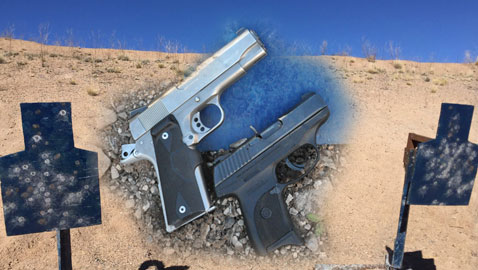 Can there be any doubt we’re living in troubled times? Terrorist attacks, civil unrest and mass shootings are on the rise, both here and abroad. In fact, as I started to write this piece I turned on the news and there is a mass-shooting situation going on in San Bernardino, California. It should be clear these events are not going away any time soon and the likelihood that any of us could be involved in one is increasing.
Can there be any doubt we’re living in troubled times? Terrorist attacks, civil unrest and mass shootings are on the rise, both here and abroad. In fact, as I started to write this piece I turned on the news and there is a mass-shooting situation going on in San Bernardino, California. It should be clear these events are not going away any time soon and the likelihood that any of us could be involved in one is increasing.
A few days ago I was listening to Michal Bane discussing the Paris terrorist attacks on his podcast and something he said encouraged me to get to the range and do some shooting. He suggested that each of us should have the skills to shoot our carry pistols at close range, but also be capable of making hits on torso sized targets at upwards to 50 yards. This means, if you aren’t able to do this with your carry pistol, you need to start practicing or reconsider your choice of pistol. For example, the Ruger LCP .380 pistol is a very popular pocket pistol – I have two of them – but I would despair of trying to hit a man with one at 50 yards. And while I shoot a lot I have to admit I don’t shoot my carry pistols as much as I should because my range time these days is often devoted to shooting and testing new guns for articles.
I went to Gunsite to work out with the two pistols I have been carrying for the past year or so. One is a Colt Lightweight Commander in .45ACP that has been modified by Gunsite, Robar, Novak’s, XS Sights and Crimson Trace. It’s the back up to my preferred LW Commander, a full-house Novak’s that had gone back to the shop for a re-hab after many years of hard use. The other carry pistol I’ve been relying on is a box-stock Ruger LC9s. My carry ammunition for the .45 is Cor-Bon DPX and I carry Hornady Critical Defense in the 9mm. I have every confidence in this ammunition, both types have functioned perfectly in these pistols and I used this carry ammo exclusively for my practice session. Using two steel targets that roughly approximate the chest and head I ran both pistols through the following drills, all fired from the holster while wearing a cover garment as I would when carrying concealed. I also incorporated movement to each stage, stepping off to one side or the other as I drew the pistol.
- 3 yards 2 shots on one target (Hammer: two very quick shots)
- 3 yards 1 shot to the head
- 3 yards failure drill (a Hammer to the body followed by a head shot)
- 3 yards 2 shots on each target (Hammer, Hammer)
- 5 yards 2 shots on each target followed by a head shot on each (Hammer, Hammer, head, head)
- 7 yards 2 shots on each target followed by a head shot on each
- 10 yards 2 shots on one target
- 15 yards Move to cover, go to kneeling and fire 2 shots on each target
- 25 yards Move to cover, go to kneeling and fire 2 shots on each target
- 50 yards Standing, 2 shots on one target (braced, from cover if available)
- 50 yards Braced kneeling, 2 shots on one target
Actually, at the range I was using it was possible to get back to 60 yards so I shot from there as well. Somewhat to my surprise, I had less trouble hitting the plate at this distance with the LC9s than I did with the Commander because that large XS Big Dot front sight, while excellent for close range shooting, was covering up so much of the target at 50 and 60 yards I had trouble getting an aiming point. Remember the Novak Commander I mentioned earlier? It has a gold bead front sight and an extra wide notch rear. I broke it out, made repeated body shots at 50 and 60 yards and even managed some headshots at 60 yards. Needless to say, it’s back to being my primary carry pistol.
Is Michael’s recommendation we should practice getting hits out to 50 yards reasonable? Some might not think so because there is a perception that shootings always take place at very close ranges. And frankly, a lot of folks disregard longer range pistol shooting because they aren’t any good at it. Consider the distance across a four-lane street or from one side of a large room – think ballroom or movie theater – and it isn’t hard to imagine finding yourself in a situation where you might have to make a longer shot. The drill I laid out here takes you from close to long range and I think it’s a reasonable practice exercise. If your pistol, or your skills are not up to par, this drill will tell you what you need to work on. In my case, it gave me an appreciation for the compact 9mm I have been using and caused me to switch from one Commander to a better one.
About the Author:
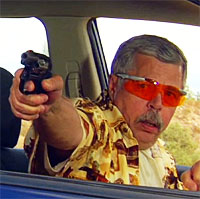 Ed Head is a regular on Shooting Gallery, Gun Stories and Down Range TV. He has worked for almost 30 years in law enforcement, first in the United States Air Force and then with the United States Border Patrol, retiring as a Field Operations Supervisor. During his Border Patrol career, Ed worked in a variety of patrol, investigative and training capacities. Ed has an extensive background as a firearms instructor, having trained thousands, ranging from beginners to police, military and special operations personnel. Having taught at Gunsite for 20 years, Ed first trained there under the world famous shooting school’s founder, Jeff Cooper, then later ran the school as the operations manager for more than five years. Ed lives in Chino Valley, Arizona, where he continues to teach and write.
Ed Head is a regular on Shooting Gallery, Gun Stories and Down Range TV. He has worked for almost 30 years in law enforcement, first in the United States Air Force and then with the United States Border Patrol, retiring as a Field Operations Supervisor. During his Border Patrol career, Ed worked in a variety of patrol, investigative and training capacities. Ed has an extensive background as a firearms instructor, having trained thousands, ranging from beginners to police, military and special operations personnel. Having taught at Gunsite for 20 years, Ed first trained there under the world famous shooting school’s founder, Jeff Cooper, then later ran the school as the operations manager for more than five years. Ed lives in Chino Valley, Arizona, where he continues to teach and write.

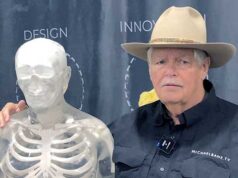
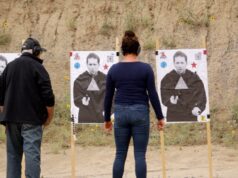
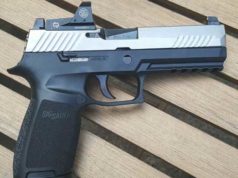
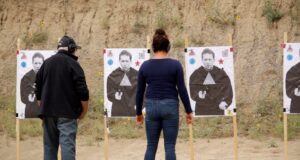
Excellent and timely article! The mindset of shooting at distance with your handgun should always be stressed!
When I was a squad leader working in the ghettos of Philadelphia, I’d invite some of my guys to my house to shoot ( I worked in Philly, but lived no where near it!!!). I have an assortment of AR500 1/2 size IPSC silhouettes set up at my house. They are from 15 to 80 yards and a full sized pepper popper at 100 yards. Most of these guys never shot past 25 yards. They would think it was insane to shoot at such “small” targets beyond 15 yards. Within a half hour they were regularly hitting steel at 50 yards and giving the pepper popper a go.
To people that don’t shoot at distance, I think there’s a mental block that beyond 25 yards is foolish to even try. When shooting at further targets, initially they’d miss. But after bearing down hits were scored. Once hits are scored, confidence is built. Some of them even became proficient at distance. After all, it’s all about the fundamentals of marksmanship.
The real eyeopener is when we’d be back at work on foot and I’d point out the distance from the row houses on one side of the street to the other. We’d walk it off. In many places it was well beyond 40 yards. Often times the distance from the street to the stoops were over 25 yards.
I gave them something to think about. Hopefully they still do. Unfortunately, most of the ranges down in that area are rarely over 25 yards and practice isn’t easily accessible.
I’m retired now and spend a good part of the summer working out at the Whittington Center. The one guy I work with and I often go shoot our handguns at 200-500 yards. Sure it’s hard. There are more misses than hits, but it’s still really, really fun!
Stay safe!
I should have added, when qualification time rolled around, where the furthest shots are 25 yards…well it seemed much easier for them.
25 yards? It’s easy when you’re regularly shooting at 50 and beyond! At 25 the targets are so much “bigger” and “closer”!
Stay safe!
Hiya Ed
Where’s an “APE” when you need him? (Ha)
During my SASS days I practiced a lot, but I never ran into the drill: Hammer, Hammer, etc.
What that is; Hammer?
Thank you for your service!
Duck
USAF, 1962-1970
Duck,
Were you a Sky Cop as well?
A Hammer consists of two fast shots. As opposed to a controlled pair (front sight press, front sight press, front sight) a Hammer is much faster and involves two shots based on the first sight picture, followed by a front sight (front sight, press, press, front sight). Three sight pictures for a controlled pair and two sight pictures for a Hammer. In both cases, the final sight picture is part of the follow-through.